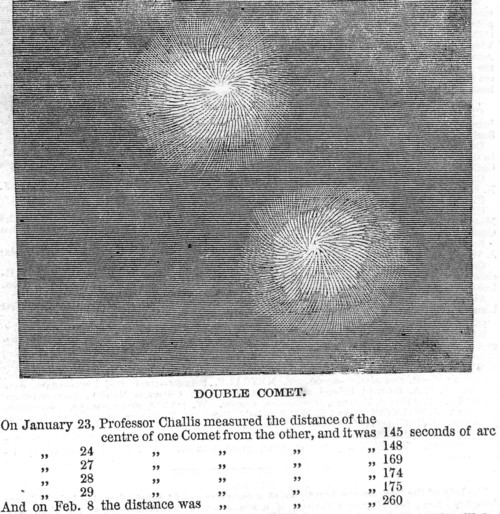To the Editor of the Illustrated London News.
Sir,—The fact of a double Comet is a circumstance of so unique and interesting a nature, that I beg to be allowed, through the medium of your columns, to communicate the following particulars, with a sketch of its appearance, which will interest very many of your readers, as this is the first instance of a phenomenon of this kind having been seen.
The drawing is from a sketch and description of its appearance by John Glaisher, Esq., at the Observatory of Dr. Lee, at Hartwell, on the evening of February 8th.
As some particulars of its history, with its predicted places, were published by you in October last, in the "Illustrated London Almanack, for 1846," I refer to that work for those particulars—remarking, however, that it was never seen double before the present time.
I shall now proceed with its history, since its discovery, on Nov. 29, 1845, at which time it was seen by Professor Encke, at Berlin. On December 1, it was discovered by Professor Challis, at Cambridge; and observed by him both on the 1st and on the 2nd day of December. At this time it appeared as a faint, misty patch of light; it had no nucleus, or central condensation of light, and was distinguishable from a faint nebula only by its motion.
On January 15, 1846, Professor Challis thought he saw a much fainter Comet, having a bright speck, near the one he was observing, but, from the improbability of finding a Comet in that position, he supposed it to be a star surrounded by haze.
On January 23rd, the Professor was surprised to see distinctly, at a short distance from the Comet, an object occupying nearly the same relative position as the object observed on the 15th, and which had all the appearance of a Second Comet, and both objects were found to move relatively as compared with a star near them. The new Comet preceded the other by five seconds; it was less bright, and of less apparent diameter than the other; each had a central condensation of light, and the coma of one did not extend to that of the other.
After this time the double Comet was seen by most observers.
On Feb. 8, as seen at Dr. Lee's Observatory, at Hartwell, the light of the greater Comet was far more intense than that of the other, but they seemed nearly to cover equal spaces, each being of a circular form. The larger one followed the other by seven seconds, and it was above it in the field of the telescope; it had a stellar nucleus, the other had nothing more than a condensation of light towards the centre: the coma of one was at times supposed to merge into the other, but the light was so attenuated that it was barely perceptible. Since the discovery of the second Comet the observed places have departed from the predicted places; at the present time the amount of this departure is about 14 minutes of arc in North Polar Distance, the observed being greater than the predicted places by this amount.

By referring to the "Illustrated London Almanack," for these days, it will be seen that the Comet is rapidly approaching the earth; but the great increase of distance is much more than can be accounted for from this cause; therefore, they are actually separating from each other.
On Jan. 23, the angle made by the line joining the two Comets, with a vertical line passing through the greater Comet, was 32° 17', and on Feb. 8, it was 24° +, so that the one appears to revolve round the other, or both round a centre of gravity.
It will be highly interesting to observe the motions of these two singular bodies; and, should there be any marked difference in their appearance, I will forward another drawing of them to you. I am, Sir, your obedient servant, Blackheath, Feb. 14, 1846. James Glaisha.
Since the above was written, Professor Challis has published a letter in the Times of Feb 16th, from which it appears that he has succeeded in obtaining observations on the Double Comet on Feb. 11th, 12th, and 13th. On the latter day the small one preceded the other by 8s'3.; and the measured distance between the two was 293 seconds of arc.